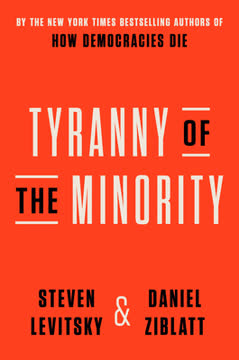Key Takeaways
1. Biden's Victory: A Truce, Not a Resolution
Yet the story of Biden’s uneasy peace with progressives—a pause in the unfinished civil war of 2016—reveals the shakiness of the new Democratic alliance.
Fragile Unity. Joe Biden's 2020 victory, while significant, represents more of a truce than a definitive resolution to the deep-seated ideological divisions within the Democratic Party. The alliance between the centrist establishment and the ascendant progressive wing remains uneasy, highlighting the ongoing struggle for the party's soul.
Lingering Questions. The fundamental questions that fueled the 2016 primary battle between Hillary Clinton and Bernie Sanders—whether to prioritize transformative progressive policies or moderate, broadly appealing ones—persist. This unresolved tension continues to shape the party's internal dynamics and its ability to present a unified front.
Existential Challenges. The Democratic Party faces existential questions about its future leadership and direction. With both Biden and Sanders aging, the party lacks a clear heir apparent who can bridge the divide between its warring factions and articulate a compelling vision for the future. The ability to maintain the current truce and find a unifying figure will be crucial for the party's success in the years to come.
2. Obama's Legacy: A Balancing Act of Progress and Pragmatism
What I do believe is that the principle of reaching out beyond the people who completely agree with you is a good principle to follow.
Bridging the Divide. Barack Obama's presidency was characterized by an attempt to bridge the divide between the Democratic Party's progressive base and its more moderate elements. He sought to balance ambitious policy goals with a pragmatic approach to governance, often emphasizing the importance of reaching out to those with differing views.
The Kalorama Meeting. A 2019 meeting between Obama and newly elected Democratic members of Congress revealed the challenges of maintaining party unity in the face of growing polarization. Obama urged the freshmen to engage in dialogue with those who held different beliefs, while also cautioning against compromising core values.
Unifying Figure. Obama's ability to captivate both young, progressive voters and older, more moderate ones made him a uniquely unifying figure within the Democratic Party. However, his departure from the political stage left a void that the party has struggled to fill, highlighting the ongoing need for leaders who can bridge the ideological gaps and articulate a shared vision for the future.
3. Justice Democrats: Igniting a Civil War for a Political Revolution
When the Vermont senator launched his first presidential bid in April 2015, he said it was designed to take on two major targets; the “immoral” and “unsustainable” economic system where “the top one percent owns almost as much wealth as the bottom ninety percent” and a “political situation where billionaires are literally able to buy elections and candidates.”
Sanders's Influence. Bernie Sanders's 2016 and 2020 presidential campaigns sparked a civil war within the Democratic Party, galvanizing a new wave of progressive activists and challenging the party's establishment. His focus on economic inequality and the influence of money in politics resonated with many voters, particularly young people.
Justice Democrats' Mission. The Justice Democrats, founded by Sanders campaign alumni, sought to carry on his mission by recruiting progressive candidates who would challenge incumbent Democrats and shift the party to the left. Their efforts led to the election of Alexandria Ocasio-Cortez, Ilhan Omar, Rashida Tlaib, and Ayanna Pressley, who formed the progressive "Squad."
Transformative Impact. Despite their limited numbers, the Justice Democrats and the Squad have had a transformative impact on Congress, pushing the Democratic Party to embrace more progressive policies and challenging the traditional power structures within the party. Their success has also fueled internal divisions and debates over the future direction of the party.
4. Ocasio-Cortez's Rise: From Bartender to Political Icon
She was also out of step with the changing face of the district.
A Rising Star. Alexandria Ocasio-Cortez's stunning primary victory over Joe Crowley in 2018 catapulted her to national prominence, transforming her from a bartender into a political icon. Her youth, charisma, and unapologetically progressive message resonated with many voters, particularly young people and those disillusioned with the Democratic establishment.
Justice Democrats' Backing. Ocasio-Cortez's campaign received crucial support from the Justice Democrats, who provided her with infrastructure, funding, and strategic guidance. The organization's decision to focus its resources on her race proved to be a pivotal factor in her success.
DSA's Ground Game. The Democratic Socialists of America (DSA) played a significant role in Ocasio-Cortez's victory, providing her with volunteers, campaign expertise, and a crucial endorsement. The DSA's support helped to mobilize grassroots activists and amplify her message, contributing to her upset win.
5. Harris's Struggle: The Perils of Being "For the People"
Her pledge is to move beyond the false choice of being ‘tough’ or ‘weak’ on crime.
A Pioneer's Path. Kamala Harris's career has been marked by a series of historic firsts, breaking barriers as a woman and a person of color in various political offices. However, her attempt to appeal to a broad range of voters by positioning herself as "for the people" has often led to criticism and a lack of clear ideological identity.
Campaign Collapse. Harris's 2020 presidential campaign struggled to gain traction, plagued by internal divisions, policy inconsistencies, and a failure to connect with key voting blocs. Her attempts to straddle the line between progressive and moderate positions often resulted in accusations of flip-flopping and a lack of authenticity.
Doubts and Uncertainties. Despite her historic achievement as the first female Vice President, doubts persist about Harris's ability to lead the Democratic Party in the future. Her struggles on the campaign trail and her perceived lack of a clear vision have raised questions about her readiness for the presidency and the future direction of the Democratic Party.
6. The Iowa Debacle: A Perfect Storm of Chaos and Missed Opportunities
We were just despondent about the situation.
Counting Catastrophe. The 2020 Iowa caucuses were marred by a perfect storm of technical glitches, organizational failures, and political infighting, resulting in a chaotic and inconclusive outcome. The Iowa Democratic Party's app malfunctioned, leading to delays, inconsistencies, and widespread confusion.
Sanders's Frustration. Bernie Sanders's campaign, which had invested heavily in Iowa and expected a strong showing, was particularly frustrated by the debacle. The lack of clear results and the ensuing media coverage undermined his momentum and contributed to his eventual loss of the nomination.
Buttigieg's Seizing of the Moment. Pete Buttigieg, despite finishing neck and neck with Sanders, seized the opportunity presented by the chaos and declared victory, shaping the narrative and gaining valuable momentum in the early stages of the primary race. The Iowa Democratic Party’s meltdown that night might have saved Biden’s campaign.
7. The Power of Endorsements: Clyburn's Kingmaker Role in South Carolina
So, let’s do this!
Clyburn's Influence. Jim Clyburn, a powerful congressman from South Carolina, has long played a kingmaker role in the state's Democratic primary. His endorsement is highly sought after, particularly among Black voters, who make up a significant portion of the Democratic electorate in South Carolina.
Biden's Comeback. In 2020, Clyburn's endorsement of Joe Biden proved to be a pivotal moment in the primary race, helping to propel Biden to a decisive victory in South Carolina and revive his struggling campaign. The endorsement signaled to Black voters that Biden was a trusted and electable candidate.
Pragmatism vs. Progressivism. Clyburn's endorsement of Biden reflected the pragmatic nature of many South Carolina Democrats, who prioritize electability and experience over ideological purity. This preference for moderation has often clashed with the more progressive wing of the party, highlighting the ongoing tension between pragmatism and progressivism within the Democratic ranks.
8. The Squad's Inside-Outside Game: Navigating Power and Principle
Being a progressive to me has always been pretty simple.
Activism in Congress. The Squad, a group of progressive congresswomen, has embraced an "inside-outside game," using their positions in Congress to advocate for progressive policies while also mobilizing grassroots activists and engaging in public advocacy. This approach has allowed them to exert influence both within and outside the traditional political system.
Clashes with Leadership. The Squad's outspokenness and willingness to challenge the Democratic establishment have often led to clashes with party leaders, particularly House Speaker Nancy Pelosi. These conflicts have highlighted the ongoing tension between the progressive wing and the more moderate elements of the Democratic Party.
Enduring Influence. Despite facing criticism and opposition, the Squad has had a significant impact on the Democratic Party, pushing the party to embrace more progressive policies and challenging the traditional power structures within Congress. Their ability to navigate the inside-outside game has made them a force to be reckoned with in Washington.
9. The Filibuster's Grip: A Senate Tradition Thwarting Progress
This House is a sanctuary.
Obstructing Legislation. The filibuster, a Senate rule that requires 60 votes to end debate on most legislation, has long been used to obstruct progress and prevent the passage of key Democratic priorities. Its origins trace back to a procedural oversight and it has been used to block civil rights legislation and other progressive reforms.
Manchin and Sinema's Resistance. Joe Manchin and Kyrsten Sinema, two centrist Democratic senators, have consistently opposed efforts to eliminate or weaken the filibuster, effectively giving the Republican minority the power to block much of Biden's agenda. Their resistance has frustrated progressives and raised questions about the future of the Democratic Party's legislative agenda.
Limited Success. Despite the challenges posed by the filibuster, Biden has managed to achieve some legislative victories, including the American Rescue Plan and the Inflation Reduction Act. However, these successes have often required compromises and concessions, highlighting the limitations of the Democratic Party's power in the face of Senate obstruction.
10. The Midterm Mayhem: New York's Democratic Disaster
If you weren’t working with them, you were not gonna win.
Red Wave Averted, But... While Democrats nationally defied expectations in the 2022 midterm elections, New York State proved to be a significant exception. The party suffered a series of losses, costing them four crucial House seats and contributing to the Republican takeover of the chamber.
Redistricting Chaos. A court-ordered redrawing of congressional districts created chaos and uncertainty, pitting incumbents against each other and disrupting established political landscapes. The new maps also favored Republicans, contributing to the Democratic Party's losses in the state.
Internal Divisions. The New York Democratic Party was plagued by internal divisions, including a lack of unity among progressives and a failure to effectively counter Republican messaging. These divisions, combined with the redistricting chaos, created a perfect storm that led to the party's disappointing performance in the midterms.
11. The Unclear Future: Doubts, Divisions, and the Search for a Unifying Figure
I think what our job right now is … I think we’ve got to keep organizing at the grassroots level, both at the Congress, for the governor’s races, for city council, school boards, whatever.
Biden's Uncertain Path. As Joe Biden heads into the second half of his first term, questions persist about his future and the future of the Democratic Party. Doubts about his age and electability, combined with the ongoing divisions within the party, create uncertainty about the path forward.
The Search for a Successor. With Biden's future uncertain, the Democratic Party lacks a clear heir apparent who can unite the party and articulate a compelling vision for the future. The absence of a unifying figure raises concerns about the party's ability to maintain its current coalition and compete effectively in future elections.
The Enduring Struggle. The Democratic Party remains locked in a struggle between its progressive and moderate wings, with each side vying for control of the party's direction. The ability to bridge this divide and find a common ground will be crucial for the party's success in the years to come, as it faces the challenges of a deeply polarized nation and a resurgent Republican Party.
Last updated:
Review Summary
The Truce receives mixed reviews, with an average rating of 3.94 out of 5. Readers appreciate its insights into Democratic Party dynamics, praising the in-depth reporting and analysis of intra-party relationships. Many find it informative and well-written, offering a clear overview of recent political events. Some criticize the book for lacking clarity on certain topics or being too politically focused. Overall, it's seen as a valuable resource for understanding the current state of the Democratic Party and its evolution over the past decade.
Similar Books










Download PDF
Download EPUB
.epub digital book format is ideal for reading ebooks on phones, tablets, and e-readers.




